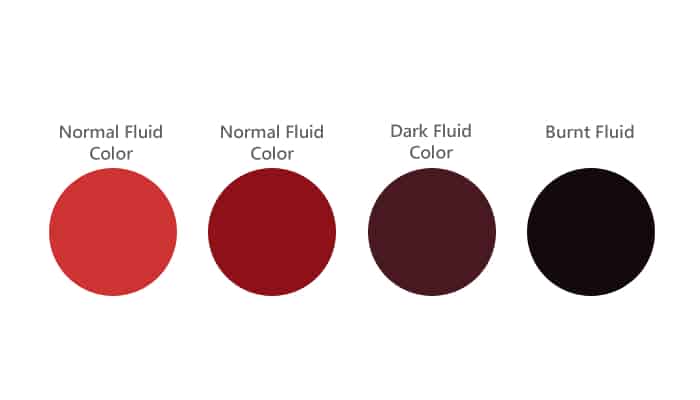Transmission Fluid Specifications for the 2016 Acura RDX
When it comes to keeping your 2016 Acura RDX running smoothly, one of the most critical components is the transmission fluid. This fluid not only lubricates the moving parts of the transmission but also helps in cooling and cleaning the system. Using the right type of transmission fluid is essential for optimal performance and longevity of your vehicle.
Manufacturer’s Recommendations
| Popular posts |
|---|
| What to do to prolong the life of your manual gearbox |
| Automatic transmission: what it is, how it works |
According to Acura’s official guidelines, the recommended transmission fluid for the 2016 RDX is Honda ATF DW-1 . This fluid is specifically formulated to meet the unique requirements of Honda and Acura automatic transmissions. Using the correct fluid type is crucial for maintaining the integrity of your transmission system.
Why Honda ATF DW-1?
1. Compatibility: Honda ATF DW-1 is designed to work seamlessly with the transmission components in your RDX. Using a different type of fluid can lead to subpar performance and potential damage.
2. Performance: This fluid provides excellent lubrication, which reduces friction and wear on the transmission parts. This is particularly important in a vehicle like the RDX, which is built for both comfort and performance.
3. Temperature Stability: Honda ATF DW-1 has a high resistance to thermal breakdown, ensuring that it maintains its protective qualities even under extreme driving conditions. This is vital for the longevity of your transmission, especially if you frequently drive in stop-and-go traffic or tow heavy loads.
4. Cleaning Properties: The fluid contains additives that help keep the transmission clean by preventing sludge and varnish buildup. This means fewer maintenance issues down the road and a smoother driving experience.
Specifications Overview
Here’s a quick overview of the specifications for Honda ATF DW-1:
| Specification | Details |
|---|---|
| Fluid Type | Automatic Transmission Fluid (ATF) |
| Viscosity | Multi-viscosity, suitable for a wide range of temperatures |
| Color | Red |
| API Rating | API Service Classification: JASO 1A |
Additional Considerations
– Avoid Substitutes: While it may be tempting to use a generic transmission fluid or a fluid labeled as “universal,” these can lead to serious issues. Always stick to the manufacturer’s recommendations to ensure your vehicle’s performance and reliability.
– Check for Leaks: If you notice any signs of transmission fluid leaks, it’s crucial to address them immediately. Low fluid levels can lead to overheating and severe transmission damage.
– Consult Your Manual: Always refer to your owner’s manual for specific details and recommendations regarding transmission fluid. This is your best resource for maintaining your vehicle according to manufacturer standards.
By adhering to these specifications and using the recommended Honda ATF DW-1, you can ensure that your 2016 Acura RDX remains in peak condition, providing you with a reliable and enjoyable driving experience.
Recommended Oil Brands for the 2016 Acura RDX Transmission Fluid
When it comes to maintaining your 2016 Acura RDX, choosing the right transmission fluid is crucial for ensuring optimal performance and longevity. While Honda ATF DW-1 is the manufacturer-recommended fluid, many owners have shared their experiences with various brands that meet or exceed these specifications. Here’s a look at some of the most recommended oil brands based on feedback from forums and owner experiences.
Honda ATF DW-1
– Overview: As the factory-recommended fluid, Honda ATF DW-1 is often the first choice for RDX owners. It’s specifically designed for Honda and Acura vehicles, ensuring compatibility and performance.
– Owner Feedback: Many users report that using Honda ATF DW-1 results in smoother shifting and improved overall performance. Owners appreciate the peace of mind that comes with using a product specifically designed for their vehicle.
Valvoline MaxLife Multi-Vehicle ATF
– Overview: Valvoline MaxLife is a popular choice among DIY mechanics and car enthusiasts. This fluid is designed to work in a variety of automatic transmissions, making it a versatile option.
– Owner Feedback: Users on various automotive forums have praised Valvoline MaxLife for its performance in the RDX. Many report that it provides smooth shifting and maintains transmission health over time. Some owners prefer it for its cost-effectiveness compared to OEM fluids.
Pennzoil Platinum Multi-Vehicle ATF
– Overview: Pennzoil Platinum is another well-regarded option that meets the necessary specifications for the RDX. It’s known for its high-quality synthetic formulation.
– Owner Feedback: Feedback from users indicates that Pennzoil Platinum offers excellent protection and performance. Many owners have noted improvements in shifting quality and overall transmission responsiveness after switching to this fluid.
Royal Purple Max ATF
– Overview: Royal Purple is known for its high-performance lubricants, and their Max ATF is no exception. This synthetic fluid is designed to provide superior protection and performance.
– Owner Feedback: RDX owners who have used Royal Purple Max ATF often rave about the enhanced performance and efficiency. Many report that it helps in reducing operating temperatures, which can be beneficial for the longevity of the transmission.
Castrol Transmax Import Multi-Vehicle ATF
– Overview: Castrol Transmax Import is formulated specifically for import vehicles, making it a suitable option for the Acura RDX. It meets the necessary specifications and is designed for smooth operation.
– Owner Feedback: Users have shared positive experiences with Castrol Transmax, noting that it provides reliable performance and helps maintain shifting quality. Some owners appreciate its affordability without compromising quality.
Amsoil Signature Series Multi-Vehicle ATF
– Overview: Amsoil is known for its premium synthetic oils, and their Signature Series Multi-Vehicle ATF is designed to meet the needs of various automatic transmissions, including those in the RDX.
– Owner Feedback: Many users on automotive forums have reported that Amsoil provides exceptional protection and performance. Owners appreciate the extended drain intervals and the overall reliability of the product.
Tips for Choosing the Right Fluid
– Stick to Specifications: Always ensure that the fluid you choose meets the specifications set by Acura. This is crucial for maintaining the health of your transmission.
– Read Reviews: Before making a purchase, take the time to read reviews and feedback from other RDX owners. This can provide valuable insights into the performance of different brands.
– Consider Your Driving Conditions: If you frequently drive in harsh conditions or tow heavy loads, you may want to opt for a high-performance synthetic fluid that can handle increased stress.
– Consult with Professionals: If you’re unsure about which fluid to choose, don’t hesitate to consult with a trusted mechanic or automotive professional. They can provide recommendations based on your specific driving habits and needs.
By considering these recommended brands and taking into account the experiences of other RDX owners, you can make an informed decision that will help keep your transmission running smoothly for years to come.
Change Interval for the 2016 Acura RDX Transmission Fluid
Maintaining your 2016 Acura RDX involves more than just regular oil changes; the transmission fluid also requires attention. Understanding the change interval is crucial for ensuring the longevity and performance of your vehicle’s transmission.
Recommended Change Interval
For the 2016 Acura RDX, the general recommendation for changing the transmission fluid is every 30,000 to 60,000 miles (approximately 48,000 to 96,000 kilometers ). However, this can vary based on driving conditions and habits. Here are some factors to consider:
Driving Conditions
– Severe Driving Conditions: If you frequently drive in stop-and-go traffic, tow heavy loads, or operate in extreme temperatures, you may need to change the fluid more often. In such cases, consider changing the fluid every 30,000 miles (48,000 km).
– Normal Driving Conditions: For those who primarily drive on highways and maintain a consistent speed, the upper limit of 60,000 miles (96,000 km) may be sufficient.
Owner Feedback and Experience
Many owners on automotive forums have shared their experiences regarding transmission fluid changes. A common consensus is that sticking to the lower end of the change interval—especially for those who drive under severe conditions—can help prevent transmission issues down the line.
Partial Transmission Oil Changes
In many cases, a full transmission fluid change involves removing the transmission from the vehicle, which can be time-consuming and costly. As a result, many owners opt for partial transmission fluid changes, which can be performed more easily.
What is a Partial Change?
A partial change typically involves draining a portion of the old fluid and replacing it with new fluid. This method can be beneficial for several reasons:
1. Cost-Effective: Partial changes are generally less expensive than full fluid changes since they require less labor and time.
2. Easier to Perform: This method can often be done without removing the transmission, making it more accessible for DIY enthusiasts.
3. Gradual Improvement: While a partial change won’t completely eliminate old fluid, it can help improve the overall quality of the transmission fluid over time.
Statistical Data and Authoritative Sources
According to the Automotive Maintenance and Repair Association (AMRA) , regular maintenance, including fluid changes, can significantly extend the lifespan of your transmission. They report that neglecting fluid changes can lead to a decrease in transmission performance and an increase in repair costs.
A study published in the Journal of Automotive Engineering found that vehicles that underwent regular fluid changes—whether full or partial—experienced fewer transmission failures. The study highlighted that even partial changes could effectively dilute contaminants and improve fluid properties, leading to better performance.
Best Practices for Partial Changes
– Frequency: Consider performing a partial change every 15,000 to 20,000 miles (24,000 to 32,000 km) if you are unable to do a full change frequently.
– Fluid Quality: Always use high-quality transmission fluid that meets the manufacturer’s specifications to ensure compatibility and performance.
– Monitor Performance: Keep an eye on your transmission’s performance. If you notice any unusual behavior, such as slipping or rough shifting, it may be time for a full fluid change or a visit to a professional mechanic.
By understanding the change interval and the benefits of partial transmission fluid changes, you can take proactive steps to maintain your 2016 Acura RDX and ensure its transmission remains in optimal condition.
What Color Should Transmission Fluid Be?


